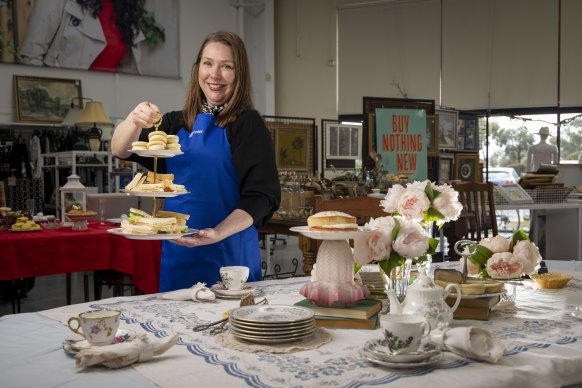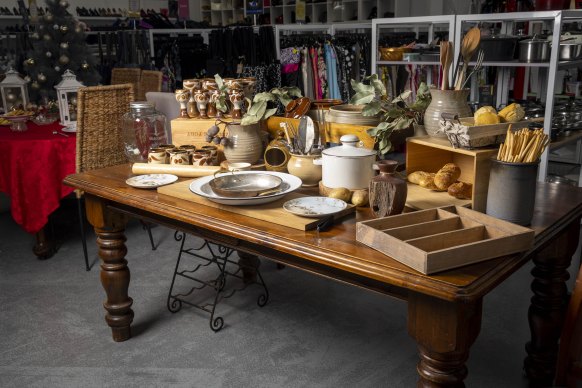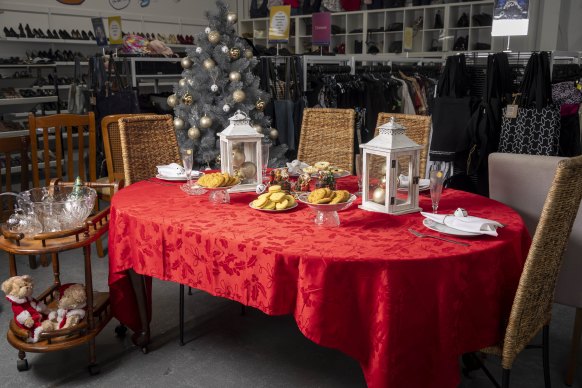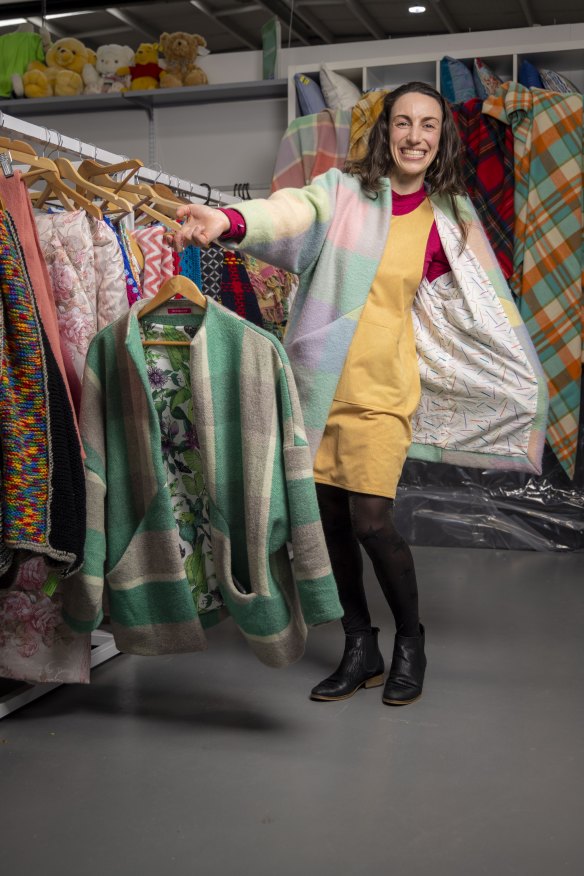When was the last time you bought something new? From mugs to mum jeans, Australians are buying – and then throwing away – massive amounts of clothing, accessories, and homewares, much of which ends up in the dreaded landfill.
It is possible to reduce waste in both your pantry and wardrobe this social season. From simply spicing up your table settings to creating an entire handmade wardrobe from scratch, repurposing secondhand items can go as far as you see fit.
Event Stylist Kerryn Howell believes anyone can create great table decor using secondhand items. Credit:Wayne Taylor
Event stylist Kerryn Howell says you don’t need to be a designer to “go on a treasure hunt”, insisting that a trip to your local op-shop could reveal gems and creative inspiration for your next special occasion – while creating half the waste for half the price.
As Creative Director at JAK Creative and Events, Howell has worked on major events like the Brownlow and Spring Racing Carnival, making her more aware than most of how wasteful buying new from chains like Kmart or Target can be.
“We are really constantly looking for ways to bring more sustainability to the process of designing things for one night, one day, one purpose,” she says. “It’s time to do life differently.”
To demonstrate how imaginative one can get with secondhand goods, Howell presents three table settings, each designed with a specific theme in mind: Christmas, kitchen tea, and Australiana.
Kerryn Howell’s Australiana table design, made entirely from secondhand items.Credit:Wayne Taylor
From vintage books used as table risers down to the bells used as napkin holders, Howell’s settings are styled entirely from items found in Vinnies op-shops, bursting with thematic flair and conjuring vivid images of festive celebrations or family summer barbecues.
Howell’s tables are the epitome of Buy Nothing New Month (BNNM), a campaign promoted by Vinnies Victoria, in which the public is encouraged to avoid purchasing brand-new items and instead opt for second-hand, or ‘pre-loved’, treasures from op-shops or recycling centres throughout October.
According to Sustainability Victoria, out of the 15.86 million tonnes of waste generated across the state in 2019-2020, 4.81 million tonnes was sent to landfill, causing more toxins to leak into the soil and increasing methane emissions.
Beginning in Melbourne in 2010, BNNM is an endeavour to get the community thinking about different ways to prevent landfill, says Vinnies Victoria spokesperson Liz Randle. “How can you rethink your purchasing habits? Do you really have to buy new, or can you buy from us, which is secondhand? Reuse, or repurpose, and keep that stuff out of landfill.”
Kerryn Howell’s Christmas-themed table for Vinnie’s Buy Nothing New Month.Credit:Wayne Taylor
Anyone can create beautiful decor using pre-loved products, Howell insists, as long as you’re equipped with an open-mind and a Pinterest account. “I just typed into Pinterest ‘DIY table decor’ and started to have a look at images. You have a world of inspiration. It’s just kind of bringing that curiosity to the creative process of what I could do.”
Howell says selecting a colour palette, creating layers and height, mismatching, and thinking outside the box (using a vintage lampshade as a table riser, for example) can turn what may initially look like an array of old, used things into part of a cohesive whole.
“You want something that creates impact when you see it from afar, but you want to keep having these little explorations and journeys and discovery and see those little details, and that’s what you can get with things from op-shops,” Howell explains.
The “mindful” process of finding and selecting items for her displays can be therapeutic, Howell says. She also notes how thrift shops bring families and communities together, bridging gaps between generations by sharing objects across time.
Claire Edwards with her handmade coats.Credit:Wayne Taylor
Claire Edwards takes ‘thrifting’ a few steps further. The 33-year-old paediatric physio very rarely buys anything new. Borrowing her mum’s sewing machine during the COVID-19 lockdown, she got to work upcycling second-hand tablecloths, woollen blankets, and doona covers to create an entirely one-of-a-kind wardrobe for herself (and a few lucky friends).
“I was making like two or three garments a week during lockdown. And I just haven’t stopped,” she says as she reveals the bright colours of the inner lining of the first coat she made – a multicoloured panel jacket sewn from an old New Zealand woollen blanket. “It’s going away from that fast fashion because there’s just there’s so much that’s cheap, not good quality, doesn’t fit right, everyone else has it, and it ends up in landfill.”
According to Charitable Recycling Australia chief executive Omer Soker, 242,842 tonnes of donations were processed across all Victorian charity shops in the last financial year. In addition, 214,368 tonnes of CO² emissions, 455,505 MWh of energy, and 21,347 ml of water were saved.
Along with her coat, Edwards’ entire outfit (bar the tights) came from her own handiwork, all the way down to her mustard yellow reversible pinafore dress made from an “old-school” tablecloth.
Environmentally conscious, personally rewarding and often relatively cheap, sustainable fashion and thrifting are gaining momentum among people in their twenties and thirties on platforms like Instagram and YouTube, says Edwards.
Instead of buying from clothing chains that sell twenty of every article deemed ‘trendy’, Edwards prefers the individualism of op-shopping. “I’ve realised how much amazing fabric is in op-shops or thrift shops,” she says. “It’s all stuff that they maybe don’t print anymore … You find some gems.”
Edwards notes the value of looking at your existing wardrobe for opportunities to repurpose or upcycle outdated or worn items you would otherwise throw away.
“There’s so much waste today in every aspect of life. A lot of the stuff that’s older is actually way better quality, and it’s made to last. So, it’s really nice being able to use what you’ve already got,” she says.
With the festive season approaching, sustainable purchasing and repurposing, no matter how small or large-scale, becomes more important than ever, says Randle.
“There’s a lot of potential waste in this coming period coming up. So, this is about keeping old stuff still in circulation,” she says. “They’re so expensive, Christmas decorations, and it’s so wasteful because then they throw it out … Donate it back when you’re finished and keep it in the circular economy.”
Make the most of your health, relationships, fitness and nutrition with our Live Well newsletter. Get it in your inbox every Monday.
Most Viewed in Lifestyle
From our partners
Source: Read Full Article




